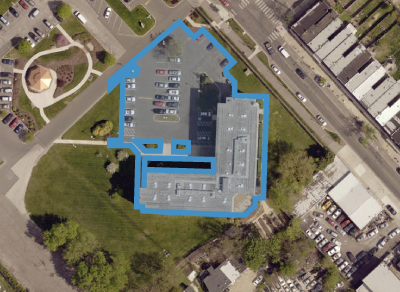Non-residential properties are those that cannot be classified as residential or condominium, and typically include commercial and industrial uses, as well as residential properties with more than four dwelling units. Mixed-use properties, such as properties with both residential and commercial use, are also considered non-residential for stormwater billing purposes.
Examples of non-residential properties
- Commercial properties
- Industrial properties
- Parking lots
- Mixed-use properties
- Vacant lots
- Row homes
- Condominium
Stormwater Charge Explained
Non-residential stormwater charges are based on a combination of the Gross Area and Impervious Area of the property. Gross Area is the total area within the legal bounds of the property, less any public right of ways. Impervious Area is any area where the surface coverage restricts water absorption, such as roofs or pavement. Each area type incurs a charge (“Gross Area charge” and “Impervious Area charge”), billed in 500 square foot units; the property’s monthly stormwater charge is the sum of the Gross Area charge and the Impervious Area charge.
For properties with multiple water accounts, the monthly stormwater charge is divided equally among all accounts. Each water account on a property is also billed a Billing & Collection charge as part of the monthly stormwater charge.
See Example Property section below for a detailed stormwater charge calculation example.
Note: cemeteries and community gardens are eligible for stormwater discounts. Learn more on the Green Spaces page →
How we measure area
Gross Area and Impervious Area measurements are determined using mapping software, aerial images of the property and digital property records.


Credits
Non-Residential properties that manage stormwater on-site may be eligible for stormwater credits, which can reduce the property’s monthly stormwater charge.
Learn more about Stormwater Credits →
Minimum Charge
Non-Residential properties whose combined gross and impervious area charges fall below a certain amount are subject to a minimum monthly stormwater charge. A property’s monthly stormwater charge cannot be reduced below the minimum charge.
Example Property
We’ll use the characteristics of an example property to walk through the calculations that make up the property’s stormwater charge.
459 Example Street
70,142 sqft
Gross Area
1,000 sqft
Gross Area Credits
36,736 sqft
Impervious Area
1,000 sqft
Impervious Area Credits
Step 1
Gross Area
Start with the property’s total gross area and factor in any credits that have been applied in order to determine the gross area charge.
Process
Gross Area Charge
$126.49
Calculate Gross Area Charge
70,142 sqft Gross Area
– 1000 sqft Gross Area Credits
69,142 sqft Modified Gross Area
500 sqft Round Up to Next 500
69,500 sqft Billable Gross Area
500 sqft Divide by 500 sqft
139 Billing Units
$0.91 Unit Charge
$126.49 Final Gross Area Charge
Step 2
Impervious Area
Use the property’s impervious area square footage and apply any applicable credits to determine the impervious area charge.
Process
Impervious Area Charge
$462.24
Calculate Impervious Area Charge
36,736 sqft Impervious Area
– 1000 sqft Impervious Area Credits
35,736 sqft Modified Impervious Area
500 sqft Round Up to Next 500
36,000 sqft Billable Impervious Area
500 sqft Divide by 500 sqft
72 Billing Units
$6.42 Unit Charge
$462.24 Final Impervious Area Charge
Step 3
Total Charge
Start with the property’s total gross area and factor in any credits that have been applied in order to determine the gross area charge.
Process
Total Stormwaer Charge
$591.34
Calculate Total Stormwater Charge
$126.49 Final Gross Area Charge
+ 462.24 Final Impervious Area Charge
$588.73 Gross + Impervious Charge
1 Divide by Accounts
$588.73 Subtotal
+ $2.61 Billing & Collections Charge
$591.34 Total Charge
Look up your stormwater charge
Search then click the address found for details.